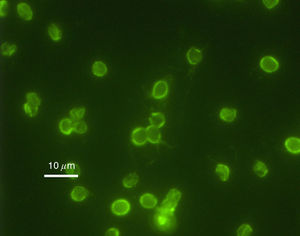Shock chlorination: Difference between revisions
| Line 8: | Line 8: | ||
<i>[http://microbewiki.kenyon.edu/index.php/Helicobacter_pylori Helicobacter pylori]</i> is known to cause gastritis and peptic ulcers. | <i>[http://microbewiki.kenyon.edu/index.php/Helicobacter_pylori Helicobacter pylori]</i> is known to cause gastritis and peptic ulcers. | ||
<br> | <br> | ||
Studies done in Peru<sup>1</sup> and Japan <sup>2</sup> have shown the presence of the bacteria in public water sources, proving its possibility as a waterborne microbe. | Studies done in Peru<sup>1</sup> and Japan<sup>2</sup> have shown the presence of the bacteria in public water sources, proving its possibility as a waterborne microbe. | ||
===<i>Cryptosporidium</i>=== | ===<i>Cryptosporidium</i>=== | ||
Revision as of 19:14, 4 November 2013
Introduction
From swimming pools to wells, chlorine is a common chemical used to disinfect water sources.
Microbial agents
Helicobacter pylori

Helicobacter pylori is known to cause gastritis and peptic ulcers.
Studies done in Peru1 and Japan2 have shown the presence of the bacteria in public water sources, proving its possibility as a waterborne microbe.
Cryptosporidium

Cryptosporidium parvum is a type of parasite capable of causing gastrointestinal illness. Unlike Helicobacter pylori, however, Cryptosporidium has been proven to be unresponsive to chlorination (citation needed).
Methods
Success rates
Alternative methods
Scientists are not content with shock chlorination. As technology advances, methods to improve both testing and disinfection are created.
References
Edited by Erika Jensen, student of Joan Slonczewski for BIOL 116 Information in Living Systems, 2013, Kenyon College.
